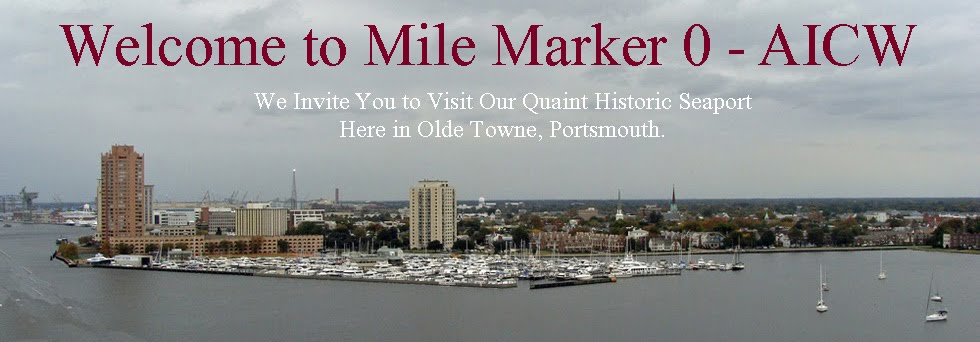 |
| Anchor in front of the Portsmouth Naval Shipyard Museum. |
Virtual Cruise of the East Coast: Portsmouth, Virginia
Re-posted in part from the article written by George Sass Sr. / Published: October 1, 2013 Yachting Magazine. Photos added for story enhancement.
As we make our approach to Portsmouth, we pass Naval Station Norfolk on Sewell’s Point, where we get a glimpse of a couple of aircraft carriers and guided-missile destroyers in port. Naturally, we give this area a wide berth, staying closer to the west side of the deep channel. This impressive facility supports up to 75 ships serving in the Atlantic and Indian oceans as well as the Mediterranean Sea.
 |
| Mile marker "0" AICW is located between Portsmouth and Norfolk, Virginia. Photo by Allen Graves. |
Over the years, we've found the Portsmouth area to be the most accommodating for us when traveling up and down the ICW. It’s close to mile zero of the ICW, and its renovated waterfront provides an attractive expanse of public green space and walking paths. An added bonus is that it’s just across the Elizabeth River from Norfolk’s Nauticus marine museum and science center, the tour-able battleship USS Wisconsin and the Waterside Festival Marketplace. We choose the Tidewater Yacht Marina for its comfortable amenities and convenient location to Portsmouth’s Olde Towne section.
After getting settled in at the marina, we walk to North Landing Park, one of the landings for the ferry to Norfolk’s Waterside. Following the waterfront for a couple of blocks, we come to High Street Park, another ferry landing where we find a number of cruising boats tied to the bulkhead for free. There’s no electricity or water, and while there are signs posted that say overnight docking is not allowed, we’re told that a couple of these snowbirds have been here for a day or two without being hassled by city officials.
On the corner of High and Water streets is the Portsmouth Naval Shipyard Museum. Covering 250 years of maritime history, the museum offers a look back at how America’s oldest and largest naval shipyard came to be so influential during Colonial days, the Civil War and especially recent times. Nearby, the U.S. lightship Portsmouth, built in 1915, is on display. We continue our walk along the city’s Path of History and discover a pavilion displaying the immense Fresnel lens from Hog Island Light, which began its service in 1896. At 10 feet high and weighing 1,500 pounds, it’s one of the largest and brightest lenses of its kind.
 |
| Riverfront pavilion displaying the immense Fresnel lens from Hog Island Light. Photo by Joe Elder. |
Walking west on High Street toward Olde Towne, we pass the Children’s Museum of Virginia, which we've heard is the perfect place to stop when cruising with kids. Fun train rides and the new Bubble Room are designed to keep the little ones entertained for hours. For us, though, it’s happy hour, so we stop at the recently reopened Gosport Tavern on High Street for an early dinner of good old-fashioned fish ’n’ chips.
 |
| The Gosport Tavern located at 702 High Street, Olde Towne Portsmouth, VA Photo by Joe Elder. |
Here is a link to the complete article online from Yachting Magazine website.




